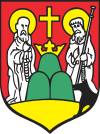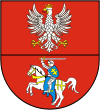Suwałki
| Suwałki | |||
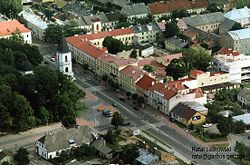 |
|||
|
|||
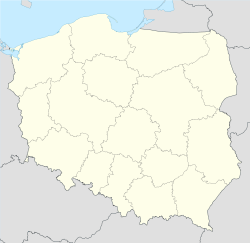 Suwałki
|
|||
| Coordinates: | |||
| Country | |||
|---|---|---|---|
| Voivodeship | Podlaskie | ||
| County | city county | ||
| Established | 1690 | ||
| Town rights | 1720 | ||
| Government | |||
| - Mayor | Józef Gajewski | ||
| Area | |||
| - Total | 65.24 km² (25.2 sq mi) | ||
| Elevation | 170 m (558 ft) | ||
| Population (2008) | |||
| - Total | 69,340 | ||
| - Density | 1,062.8/km² (2,752.8/sq mi) | ||
| Time zone | CET (UTC+1) | ||
| - Summer (DST) | CEST (UTC+2) | ||
| Postal code | 16-400 to 16-403 | ||
| Area code(s) | +48 087 | ||
| Car plates | BS | ||
| Website: http://www.um.suwalki.pl/ | |||
Suwałki [suˈvau̯kʲi] (![]() listen) (Lithuanian: Suvalkai; German: Suwalken and Sudauen between 1939 and 1944) is a town in northeastern Poland with 69,340 inhabitants (2008). The Czarna Hańcza river flows through the town.
listen) (Lithuanian: Suvalkai; German: Suwalken and Sudauen between 1939 and 1944) is a town in northeastern Poland with 69,340 inhabitants (2008). The Czarna Hańcza river flows through the town.
It is the capital of the Suwałki County and one of the most important centres of commerce in the Podlaskie Voivodeship. Until 1999 the town was the capital of Suwałki Voivodeship. Suwałki is located about 30 km from the southwestern Lithuanian border. One Lithuanian ethnographic region is named Suvalkija, and that name came from this town. The town also gives its name to the Polish protected area known as Suwałki Landscape Park.
Contents |
History
The area of Suwałki has been populated by local Yotvingian and Prussian tribes since the early Middle Ages. However, with the arrival of the Teutonic Order to Sudovia, their lands were conquered and remained largely depopulated in the following centuries. The village was founded by Camaldolese monks, who in 1667 were granted the area surrounding the future city by Grand Duke of Lithuania John II Casimir. Soon afterwards the monastic order built its headquarters in Wigry, where a monastery and a church were built. The new owners of the area started fast economic exploitation and development of the forests and brought enough settlers (mainly from over-populated Masovia) to build several new villages in the area. Also, production of wood, lumber, tar and iron ore was started.

The village was first mentioned in 1688; two years later it was reported to have two houses. However, the growth of the village was fast and by 1700 it was split onto Małe Suwałki and Wielkie Suwałki (Small and Great Suwałki). The village was located almost exactly in the centre of Camedulian estates and it was located on the main trade route linking Grodno and Merecz with Königsberg. That is why in 1710 King Augustus II the Strong granted the village a privilege to organise fairs and markets. Five years later, in 1715, the village was granted city rights by the grand master of the order, Rev. Ildefons. The town was divided into 300 lots for future houses and its inhabitants were all granted civil rights and freed from taxes for seven years. In addition, the town was granted with 18.03 square kilometres of forest that was to be turned into arable land. On May 2, 1720, the city rights were approved by King August II, and the town was allowed to organise one fair a week and four markets a year. In addition, a coat of arms was approved, depicting Saint Roch and Saint Romuald.
After the Partitions of Poland in 1794 the area was annexed by Prussia. In 1796 the monastery in Wigry was closed and its property confiscated by the Prussian government. The following year a seat of local powiat authorities was moved to the town, as well as a military garrison. By the end of 18th century, Suwałki had 1,184 inhabitants and 216 houses. A large part of them were Jewish.
In 1807 Suwałki was annexed by the newly-formed Duchy of Warsaw and became one of the centres of department of Łomża. After the defeat of Napoleon Bonaparte and the Congress of Vienna, the area was incorporated into the Kingdom of Poland. The status of a powiat capital was briefly withdrawn, but it was re-introduced on January 16, 1816, when Augustów Voivodeship was created and its authorities were gradually moved to Suwałki. Soon afterwards the old city hall was demolished and replaced with a new one, and General Józef Zajączek financed the paving of all the city's streets. Also, the cemetery was moved from the town centre to the outskirts, while the area was turned into a romantic city park. Also, a new road linking Warsaw with St. Petersburg was built, which added to the city's prosperity.
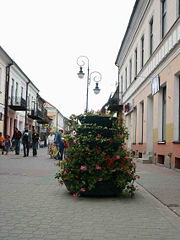
Also, new streets were paved and new facilities opened. In 1820 a new church was built and the following year the first synagogue was opened. In 1829 a permanent post office was opened in Suwałki. Between 1806 and 1827 the town's population almost tripled and reached 3,753 people living in 357 houses. During the November Uprising of 1831 the town's population took part in the struggles against Russia, but the city was taken by the Russian army on February 11. In 1835 Tsar Nicholas I declined to move the capital of voivodeship to Augustów and the fate of Suwałki was sealed. Two years later the Voivodeships of Poland were renamed to gubernias and so the town became the capital of Augustów Gubernia.
In 1826 an investment plan was passed and new buildings were started by the state authorities. In 1835 a police station was finished, in 1844 a new town hall, and Orthodox and Protestant churches. Soon afterwards a new marketplace was opened, as well as St. Peter's and Paul's hospital and gymnasium. In addition, between 1840 and 1849 the main Catholic church was refurbished by many of Poland's most notable architects of the era, including Piotr Aigner, Antoni Corazzi and Enrico Marconi. To change the city's climate and break with the rural past, in 1847 the city council passed a law banning construction of new wooden houses.
The city's population continued to grow rapidly. In 1857 it had 11,273 inhabitants and in 1872 almost 20,000. Newly-built factories needed workers and these were brought from all over the world. Because of that, the mixed Polish-Jewish population was soon joined by people of almost all denominations that worshipped in the Russian Empire. Soon the city became the fourth most populous town in the Kingdom of Poland. After the January Uprising of 1863, the new administrational reform was passed to unify the Polish lands with Russia completely. In 1866 the gubernia of Augustów was finally renamed to Suwałki Gubernia. However, the newly-built Warsaw-Petersburg rail road passed by Suwałki and the town's prosperity ended. It was not until the early 20th century, when the arrival of new Russian army garrisons brought the economy back on track. Also a railroad line was finally completed, linking Suwałki with Grodno.

After the spring of 1905, when the Russians were forced to accept a limited liberalisation, the period of Polish cultural revival started. Although the Polish language was still banned from official use, new Polish schools were opened, as well as a Polish-language Tygodnik Suwalski weekly and a library. After the Great War broke out, heavy fights for the area erupted. Finally in 1915, the Germans broke the Russian front and Suwałki was put under German occupation. The town and surrounding areas were detached from the rest of the Polish lands and were directly administered by the German military commander of the Ober-Ost Army. Severe laws imposed by the German military command and the tragic economic situation of the civilians led to the creation of various secret social organisations. Finally, in 1917, local branches of the Polska Organizacja Wojskowa were created.
After the collapse of the Central Powers in November 1918, the local commander of the Ober-Ost signed an agreement with the Temporary Council of the Suwałki Region and de facto allowed for the region to be incorporated into Poland. However, the German army remained in the area and continued its economic exploitation. In February 1919 the local inhabitants took part in the first free elections to the Polish Sejm, but soon afterwards the German commanders changed their mind and expelled the Polish military units from the area and in May passed it to Lithuanian authority. By the end of July the Paris Peace Conference granted the city to Poland and the Lithuanians withdrew from the city, but some of the Polish-inhabited lands were left on the Lithuanian side of the border while several Lithuanian villages were left on the Polish side of the so-called Foch Line. This led to the outbreak of the Sejny Uprising on August 23, 1919. To secure the city, the following day the first regular units of the Polish Army entered Suwałki. A short Polish-Lithuanian War erupted and for several days limited fights were fought for the control over Suwałki, Sejny and other towns in the area. The war ended on the insistence of the Entente in mid-September (negotiations took place in Suwałki in early October). During the Polish-Bolshevik War the city was captured by the Reds and after the Battle of Warsaw it was again passed to the Lithuanians, but it was retaken by the Polish Army with negligible losses soon afterwards.
In the interbellum Suwałki became an autonomous town within the Białystok Voivodeship (1919-1939). This led to yet another period of prosperity, with the city's population rising from 16,780 in 1921 to almost 25,000 in 1935. The main source of income shifted from agriculture to trade and commerce. Also, in 1931 the new water works and a power plant were built. Also, Suwałki continued to serve as one of the biggest garrisons in Poland, with two regiments of the Polish 29th Infantry Division and almost an entire Suwałki Cavalry Brigade stationed there. Since 1928 Suwałki was also the headquarters of one of the battalions of the Border Defence Corps.

During the later stages of the Polish Defensive War of 1939 the town was briefly captured by the Red Army. However, on October 12 of the same year the Soviets withdrew and transferred the area to the Germans, in accordance with the Nazi-Soviet Alliance. The town was renamed to Sudauen and incorporated directly into the German Reich's East Prussia. Severe laws and terror that erupted led to the creation of several resistance organisations. Although most of them were at first destroyed by the Gestapo, by 1942 the area had one of the strongest ZWZ and AK networks. Despite the resistance, almost all of the city's once 7,000-strong Jewish community was murdered in German concentration camps. Also, in Suwałki's suburb of Krzywólka a POW camp for almost 120,000 Soviet prisoners of war was established. On October 23, 1944, the city was captured by the forces of the Soviet 3rd Belarusian Front. The fights for the city and its surroundings lasted for several days and took the lives of almost 5,000 Soviet soldiers. The anti-Soviet resistance of former Armia Krajowa members lasted in the forests surrounding the city until the early 1950s.
After the war, Suwałki remained a capital of the powiat. However, the heavily-damaged town recovered very slowly and the Communist economic system could not help the city's problems. This period came to an end in 1975, when a new administrative reform was passed and Suwałki yet again became the capital of a separate Suwałki Voivodeship. The number of inhabitants rose rapidly and by the end of the 1970s it was over 36,000. Large factories were built in the city and it became one of the important industrial and commercial centres of Eastern Poland.
After the peaceful dissolution of the Communist system in Poland in 1989 the city experienced a period of economic difficulties. Most of the city's major factories were inefficient and went bankrupt. However, the creation of the Suwałki Special Economic Zone and the proximity of the Russian and Lithuanian borders opened new possibilities for the local trade and commerce. In addition, the ecologically clean region started to attract many tourists from all around the world.
Trivia
In 2001 it was reported to the Polish radio station Radio ZET that Windows Word (PL) crashed whenever the spelling checker encountered the word 'Suwałki'. One of the station's presenters, famous for making comic telephone calls on the air, incorporated this into one of his broadcasts by telephoning Microsoft Polska and asking them what they had against the place. The software error has since been repaired.
Tourist attractions
- Kościuszko street with classicist architecture
- Romantic 19th century park
- St. Alexander's Church
- St. Peter and Paul's Church
- Cemetery complex at Bakałarzewska street (Roman Catholic, Orthodox, Protestant, Jewish and Muslim)
- Municipal museum
- Town Hall
- Former gymnasium building
- Museum and monument to Maria Konopnicka
- 19th century brewery of Wacław Kunc
Education
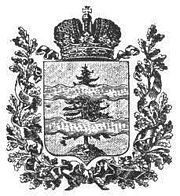
- Wyższa Szkoła Służby Społecznej im. Ks. Franciszka Blachnickiego
- Wyższa Szkoła Suwalsko-Mazurska im. Papieża Jana Pawła II
- Państwowa Wyższa Szkoła Zawodowa w Suwałkach
People
- Knut Olof Falk (1906 - 1990), Swedish slavist
- Josef Hassid (1923 - 1950), violinist
- Adam Koc (1891 - 1969), soldier, politician and journalist
- Maria Konopnicka (1842-1910), poet
- Mieczysław Mackiewicz (1880 - 1954), general
- Henryk Minkiewicz (1880 - 1940), general, killed in the Katyn Massacre
- Emil Młynarski (1870 - 1935), composer and conductor
- Aleksandra Piłsudska (1882 - 1963), wife of Józef Piłsudski and the Polish first lady
- Zygmunt Podhorski (1891 - 1960), general, cavalry commander
- Pinchas Sapir (1906-1975), Israeli politician, Minister of Finance
- Avraham Stern (Yair) (1907 - 1942), poet and Jewish resistance fighter
- Edward Szczepanik, economist and the last Polish Prime Minister in Exile
- Andrzej Wajda, film director
- Alfred Wierusz-Kowalski (1849 - 1915), painter
Twin Towns
Suwałki is twinned with:
|
See also
- Suvalkai region
- Augustów Canal
External links
|
||||||||||
|
|||||||
